Proper laser cutting results don’t just rely on machine power or material type—they begin with consistent maintenance and a deep understanding of processing techniques. Whether you’re a beginner or seasoned user, mastering the basics like lens care, air assist settings, and platform choices will dramatically improve your laser cutting efficiency and precision.
This guide walks you through essential maintenance routines and advanced tips to help you elevate your laser processing workflow.
Let’s get started!
1. Laser Machine Routine Maintenance Work
Before starting any laser cutting task, it’s crucial to ensure that key foundational elements of your system are in optimal condition. Clean optics, a flat working surface, and correct focal distance are essential for achieving smooth, precise cuts. Neglecting these details can compromise the quality of your laser cutting results and may even shorten the lifespan of your machine. The following steps will help you maintain peak performance right from the start.
Step #1: Inspecting and Cleaning Focus Lens
It is imperative that you remove, inspect, and clean your optics before running the machine for the first time. And also because we have seen the optics (particularly the mirrors) being received tarnished, possibly due to environmental conditions during transport and so on. Every machine is tested before it leaves the factory but the optics can get fouled. We have determined that the optics are not damaged, so clean them up and you will be good to go.
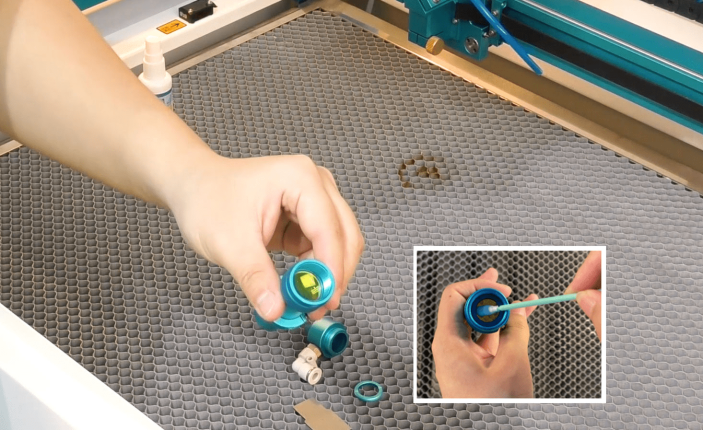
Step #2: Make Sure the Laser Material is Flat
Flatness is an often-misunderstood attribute of our intuition. Many of the objects we think of as flat pales in comparison to the surfaces that are actually made flat. In laser machining, flatness is the key attribute for the success of cutting and engraving.
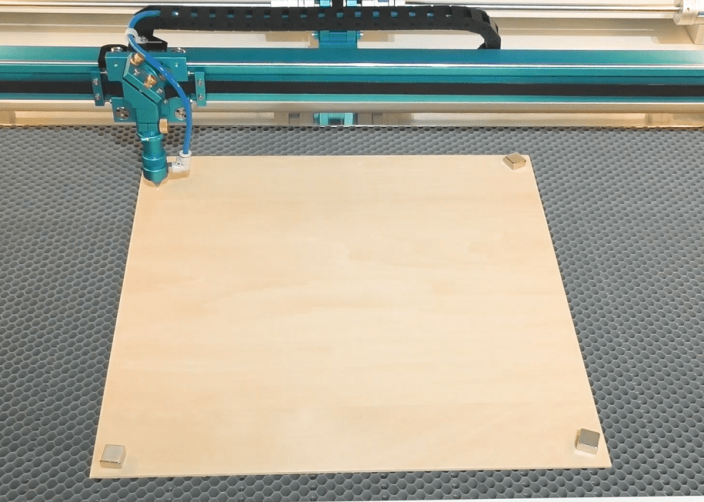
Step #3: Adjust the Right Focal Length
The smaller the spot when the laser beam comes into contact with the material, the better. To get a good cut or engraving you need to know where you laser is focusing correctly. Taking the Thunder Laser laser cutter as an example, 6mm is the most appropriate distance.
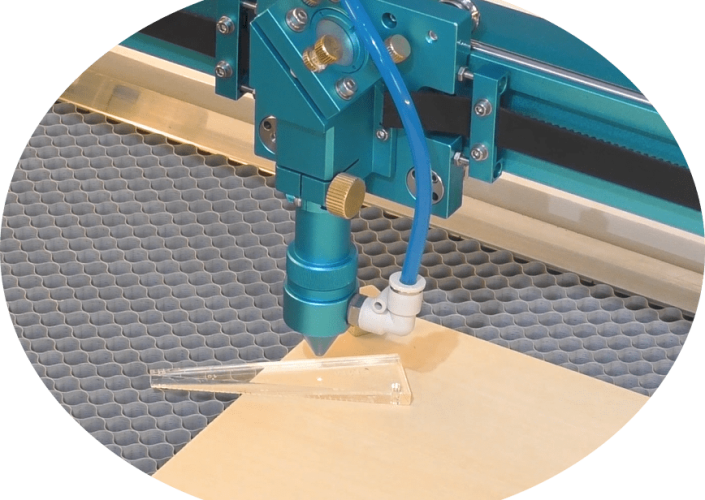
2. Master More Laser Cutting Skills
Before diving into advanced laser cutting configurations, it’s essential to understand how different accessories and setups can influence your final result. From air pressure adjustments to worktable choices and rotary attachments, each element plays a vital role in refining your laser cutting process.
The following sections will walk you through key techniques that can help you achieve cleaner edges, minimize material damage, and unlock more creative laser engraving possibilities.
2.1 High Air Compressor is Used to Assist Laser Cutting
When laser cutting thick materials (> 10mm), the usage of high air compressor can reduce the carbonization of materials.
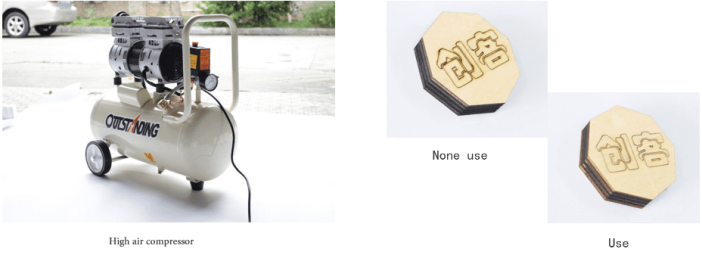
2.2 Dual Air Assist System
Laser Engraving Wood: When carving wood, set no blowing, carving effect is the best, the surface of the workpiece is clean and clear.

Laser Cutting Acrylic: The frosting, is from using too much air. the air is solidifying it prematurely so you are not getting that flame polished edge. When cutting acrylic, you want just enough air to mitigate the flames and expel the resultant gasses.
For an even weaker blowing effect, it is recommended to use it with the 6mm nozzle in the toolbox. By slowing down and reducing blowing, you can cut smooth acrylic!

2.3 Using Honeycomb or Blade Laser Cutting Table
Before processing, it is necessary to keep the honeycomb platform clean and clean up the fine waste left by the platform. It is more convenient to use tools such as vacuum cleaner.

The blade platform is located under the cellular platform. Remove the cellular platform and use the blade platform directly. The density of the blade platform can be adjusted according to the size of the workpiece. The workpiece is suspended in a large area during processing, which greatly reduces the influence of laser reflection and makes the cutting effect reach the best state.
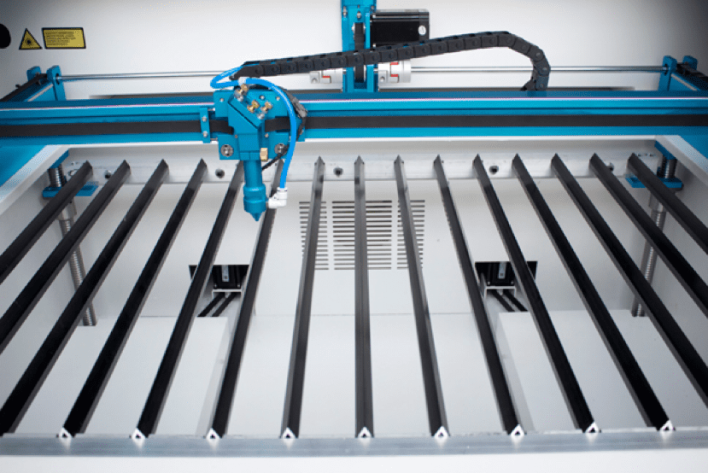
Processing thick materials, such as 10mm wood, due to the high thickness of the material needs to use high power and slow processing, the use of honeycomb plate platform is easy to produce serious reflection, resulting in the bottom of the workpiece yellow, the use of blade cutting table can reduce reflection.
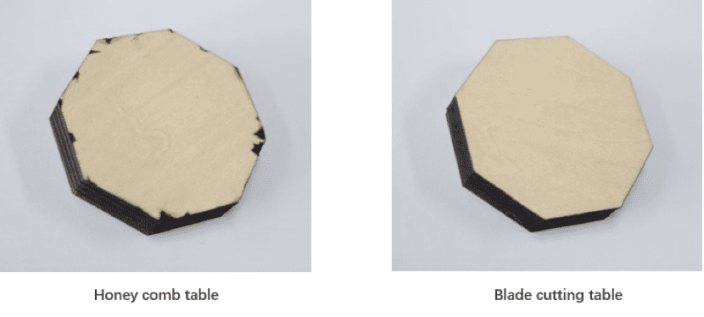
When processing the works of bending structure, because the bending structure is composed of a number of dense line segments, processing on the blade cutting table can reduce the reflection of the back of the material, and the effect is better.

2.4 Use Motorized Table for Laser Engraving
When processing large wooden boxes and other large objects, the lifting platform can be used to adjust to the appropriate processing position; At the same time, with a fixed fruit mold, it can also process larger vegetables and fruits, such as big watermelon, pumpkin, etc., which is more creative.

By lowering the lifting platform and setting a larger focal length, the larger focal length and the thicker light spot will deepen and thicken the tracing effect to create a different processing effect.
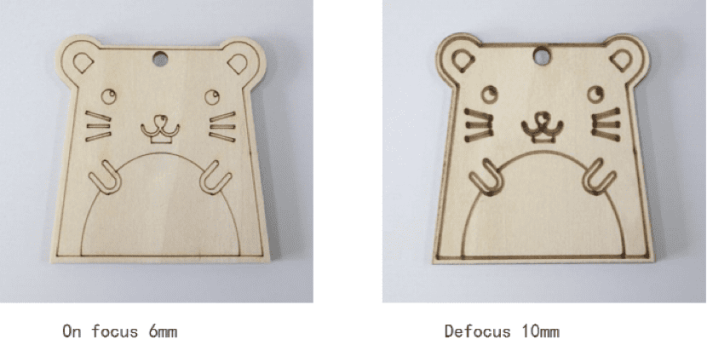
2.5 Use Laser Rotary
Rotary shaft tools are used to work cylindrical objects such as glass, cups or bamboo tubes. Because the rotating shaft has a certain height, it needs to be used together with the lifting platform when processing, and the processing platform needs to be properly reduced.

In processing difficult to fix the object, according to the characteristics of the object, make a fixed mold, so that it can be stably fixed in it, easy to process.

Conclusion:
From routine maintenance to mastering airflow, table setup, and rotary use, every detail contributes to better laser cutting performance. Implementing these practices not only ensures higher accuracy and cleaner cuts but also extends the life of your machine. Stay consistent, keep learning, and your laser cutting results will speak for themselves.


.png) International
International
 United States
United States
 Brasil
Brasil
 Canada
Canada
 Costa Rica
Costa Rica
 Česká
Česká
 Ελλάδα
Ελλάδα
 Polska
Polska
 Ireland
Ireland
 Portugal
Portugal
 Lietuva
Lietuva
 Россия
Россия Deutschland
Deutschland
 Britain
Britain
 Україна
Україна
 France
France
 Sverige
Sverige
 Italia
Italia
 Norway
Norway
 Denmark
Denmark
 Romania
Romania
 한국
한국
 中国
中国
 ประเทศไทย
ประเทศไทย
 中国香港
中国香港
 Israel
Israel
 中國臺灣
中國臺灣
 India
India
 پاکستان
پاکستان
 پශ්රී ලංකා
پශ්රී ලංකා
 ジャパン
ジャパン
 Australia
Australia
 New Zealand
New Zealand
 South Africa
South Africa